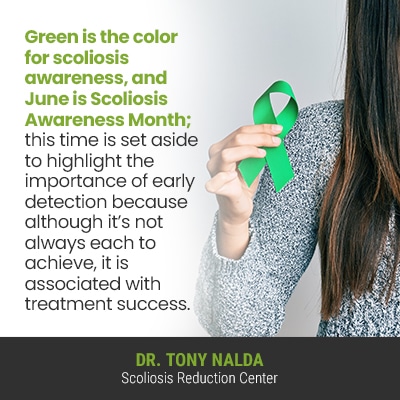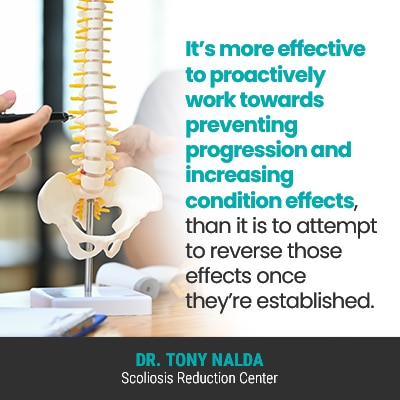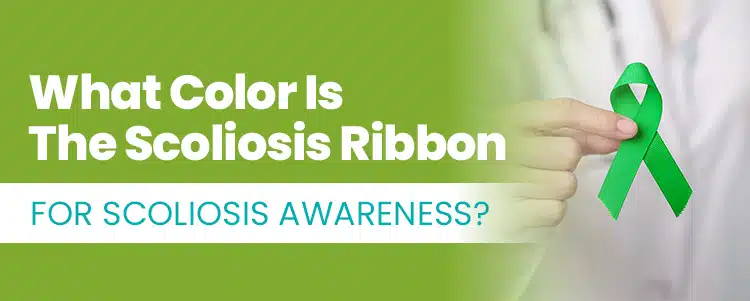Scoliosis is a highly-prevalent progressive spinal condition, and when it comes to progressive conditions like scoliosis, sometimes when treatment is started is as important as the type of treatment started. Being proactive with treatment is key because scoliosis only gets more complex to treat the more it progresses, and awareness can help achieve early detection.
The scoliosis ribbon for scoliosis awareness is green, and scoliosis awareness month is June. While there are never treatment guarantees, early detection can be highly beneficial in terms of treatment efficacy, so spreading awareness is important because it can lead to early detection and intervention.
When scoliosis is detected early, treatment can be started early in a condition’s progressive line, so let’s start with how the condition is diagnosed.
4 Key Takeaways
- Importance of Early Detection: Early detection of scoliosis can lead to more effective treatment outcomes. Being proactive with treatment is crucial since scoliosis is a progressive condition that becomes more complex to treat as it advances.
- Scoliosis Awareness Month: June, represented by the green ribbon, is Scoliosis Awareness Month. This time is dedicated to spreading awareness about the condition, emphasizing the benefits of early detection and the potential for effective intervention.
- Diagnosis and Classification: Scoliosis is diagnosed and classified based on the Cobb angle measurement, which helps in determining the condition’s severity. This classification is essential for crafting an effective treatment plan.
- Natural Management vs. Surgery: Scoliosis can be managed conservatively through a multidisciplinary approach that includes chiropractic care, physical therapy, and bracing, offering a non-surgical option that contrasts with the traditional surgical route.
Diagnosing and Classifying Scoliosis
When it comes to diagnosing scoliosis, there are a number of parameters that have to be met.
Scoliosis is the development of an unnatural lateral (side-to-side) spinal curve that also twists, and it’s the rotational element that makes scoliosis a complex 3-dimensional condition.
In addition, the unnatural spinal curve has to have a minimum Cobb angle measurement of 10 degrees, and this measurement is also important when it comes to assessing, classifying, and treating scoliosis.
A patient’s Cobb angle is determined during X-ray by drawing lines from the tops and bottoms of the curve’s most-tilted vertebrae, and the resulting angle is expressed in degrees and classifies conditions in terms of severity:
- Mild scoliosis: Cobb angle measurement of between 10 and 25 degrees
- Moderate scoliosis: Cobb angle measurement of between 25 and 40 degrees
- Severe scoliosis: Cobb angle measurement of 40+ degrees
- Very-severe scoliosis: Cobb angle measurement of 80+ degrees
The higher a patient’s Cobb angle, the more severe the condition, the further out of alignment a scoliotic spine is, and the more likely it is that the condition’s effects are going to be noticeable.
Part of diagnosing scoliosis involves further classifying it based on key patient/condition variables such as patient age, condition type, severity, and curvature location, and these classification points help streamline the treatment process, in addition to informing the customization of treatment plans.
Let’s now talk about scoliosis awareness and why it’s so important.
What is the Color for Scoliosis Awareness?

Green is the color for scoliosis awareness, and June is Scoliosis Awareness Month; this time is set aside to highlight the importance of early detection because although it’s not always each to achieve, it is associated with treatment success.
As a progressive condition, scoliosis has it in its nature to worsen over time, and this means the size of the unnatural spinal curve is increasing, as are the condition’s uneven forces, and their effects.
As progression occurs, conditions are becoming more severe, and the spine is becoming increasingly rigid, and this loss of flexibility can make it less responsive to treatment; the focus of a conservative treatment approach is condition-specific chiropractic care.
In addition, increasing levels of spinal rigidity can also make it challenging for some patients to perform certain therapeutic exercises as part of treatment.
Now, it can be hard to understand how an unnaturally-curved spine can be difficult to detect early, but this is actually the case for a number of reasons.
Ranging from mild to very severe, no two cases are the same, and in mild cases, the condition’s effects are known to be mild and difficult for anyone, other than a trained expert, to recognize.
There are also different types of scoliosis, and while the condition affects all ages, it’s most commonly diagnosed in adolescents between the ages of 10 and 18 as adolescent idiopathic scoliosis.
While pain is not something we want to experience, it does serve a vital purpose; it tells us when something is wrong with the body, and scoliosis isn’t commonly painful in children, which can make it difficult to detect, particularly while mild.
Scoliosis doesn’t become a compressive condition until skeletal maturity has been reached, and this is when compression of the spine and its surrounding muscles and nerves causes pain, and this is what brings most adults in for a diagnosis and treatment.
In fact, the most common type of scoliosis to affect adults is idiopathic scoliosis, and cases of idiopathic scoliosis in adults are adolescents who had adolescent idiopathic scoliosis but didn’t receive a diagnosis or treatment during adolescence; this is a common scenario as it’s not often until conditions become painful that professional help is sought after.
In young patients whose spines are still growing, the constant lengthening motion of a growing spine counteracts the compressive force of the unnatural spinal curve, and this is why scoliosis doesn’t commonly cause back pain in children.
Why is Scoliosis Awareness Important?
As mentioned, while there are no treatment guarantees, with scoliosis that’s diagnosed and treated early, there are fewer limits to what can be achieved.
Scoliosis gets more complex to treat the more severe it gets, so it makes sense to start treatment as early as possible before conditions have progressed, spines have become more rigid and less responsive, and before the body has had time to adjust to the presence of the unnatural spinal curve.
Scoliosis-effects get more noticeable the more severe a condition is, and scoliosis can also cause a related muscle imbalance; the unnatural spinal curve pulls the spine’s surrounding muscles in different directions, and this can cause muscles on one side of the spine to become stretched and loose from overuse, and muscles on the opposite side can become weak from underuse.
It’s more effective to proactively work towards preventing progression and increasing condition effects, than it is to attempt to reverse those effects once they’re established.
Scoliosis awareness is important because, particularly in children for whom the condition is not yet impressive, the condition’s early signs can be difficult to notice; in fact, it’s not often until a condition has progressed from mild to moderate that its effects become noticeable.

In children, the main effect of scoliosis is postural deviation caused by how the condition’s uneven forces disrupt the body’s overall symmetry, and some early condition indicators to watch for in children can include:
- Uneven shoulders
- Uneven shoulder blades
- The development of a rib arch
- Uneven hips
- Arms and legs that appear to hang at different lengths
Additional signs to watch for are changes to coordination, balance, gait, and clothing suddenly seeming ill-fitting; while noticing a single bodily asymmetry doesn’t guarantee a diagnosis of scoliosis, it does warrant the need for further testing, especially considering the benefits of early detection.
In mild cases, postural changes can be subtle, the condition is unlikely to be painful in children, and functional deficits are rare, and this is why being aware of the condition’s subtle early indicators is so important.
In adults, the condition’s main symptom is pain, which is why adult scoliosis tends to be easier to detect than in children.
When scoliosis is treated proactively and conservatively, a curvature reduction can be worked towards and core strength can be increased so the spine is optimally supported by its surrounding muscles.
Conclusion
The green scoliosis awareness ribbon draws attention to the importance of early detection because as a progressive condition, the sooner treatment is started, the better.
With the Scoliosis Research Society putting current estimates at close to seven million people living with scoliosis in the United States alone, the condition’s prevalence alone warrants education and awareness.
Here at the Scoliosis Reduction Center®, I treat patients non-surgically with a conservative chiropractic-centered treatment approach.
I integrate multiple condition-specific treatment disciplines such as chiropractic care, physical therapy, corrective bracing, and rehabilitation so conditions can be impacted on every level for long-term sustainable treatment results.
When scoliosis is left untreated, it’s virtually guaranteed to progress at some point, and as growth is the condition’s progressive trigger, children, particularly adolescents going through puberty, are at risk for rapid-phase progression.
For those following traditional scoliosis treatment, when/if a condition progresses into the severe classification, they are commonly told that spinal fusion is the best and only remaining treatment option, and spinal fusion carries some serious potential risks, side effects, and complications.
Some patients who are funneled into surgical treatment are unaware that there is another less-invasive non-surgical treatment option available, and the reality is that many cases of scoliosis don’t require surgery, especially with early detection and intervention.
What I want most from scoliosis awareness is for patients to have the knowledge that surgery is neither the best, nor only treatment option available, and for parents and/or caregivers to be aware of the condition’s early signs so early detection is possible.




